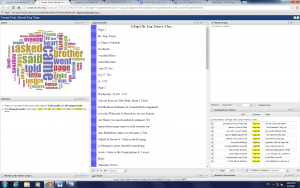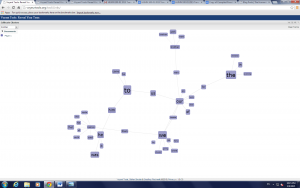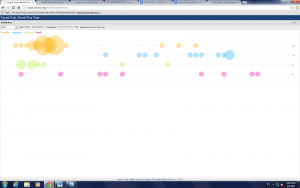Humanists always spend too much time on exploring useful information from tremendous humanity database. The theme of the book, the intentions of authors and the subtle evidence of the contemporary lives, culture and thoughts are all hidden in hundreds of pages, or even more, of humanity materials. However, nowadays, humanity exploration no longer consumes as much time as we had before. The distant reading method can help readers to compact hundreds of pages into simple visual images. Such images can not only help readers find what the author focus on, but also can help readers find the relationship between different terms. To better understand the distant reading method, I will use DH method to explore the question “what are the major groups of people Payne and Froehlich met” from the full compiled transcription of the Payne/Froehlich Travel Journal.
The picture on the right is cirrus which creates a word cloud in which the more frequently the word appear, the bigger the word. By finding the large words, we can easily find out what the author mentioned most. Therefore, to find who did Payne and Froehlich meet, we can simply find the large words of people’s name or people’s group. For example, the words “negroes” and “ brother” are large which suggests that negroes and brothers would be people Payne and Froehlich always care or meet.
frequently the word appear, the bigger the word. By finding the large words, we can easily find out what the author mentioned most. Therefore, to find who did Payne and Froehlich meet, we can simply find the large words of people’s name or people’s group. For example, the words “negroes” and “ brother” are large which suggests that negroes and brothers would be people Payne and Froehlich always care or meet.
To find the relationship among different people, Links would be a good choice.  When I find the names of people, I clicked the names, and the links increased. It shows that “we” and “negroes” are linked together, which indicates an interaction between Payne and Froehlich and negroes. Also, the the Links shows no interaction between brother, children and negroes but an interaction between brother, children and Payne and Froehlich.
When I find the names of people, I clicked the names, and the links increased. It shows that “we” and “negroes” are linked together, which indicates an interaction between Payne and Froehlich and negroes. Also, the the Links shows no interaction between brother, children and negroes but an interaction between brother, children and Payne and Froehlich.
Bubblelines shows the relative locations of different words in the text. I put some of the names that I found form the cirrus into bubblelines. I find out that most “brother” and “children” spread at the front of the article and negroes spread from the middle to the end, which provides evidence that during their journey, Payne and Froehlich first pay a lot more attention on brother and children. Later, they pay more attention on negroes.
of the names that I found form the cirrus into bubblelines. I find out that most “brother” and “children” spread at the front of the article and negroes spread from the middle to the end, which provides evidence that during their journey, Payne and Froehlich first pay a lot more attention on brother and children. Later, they pay more attention on negroes.
Leave a Reply